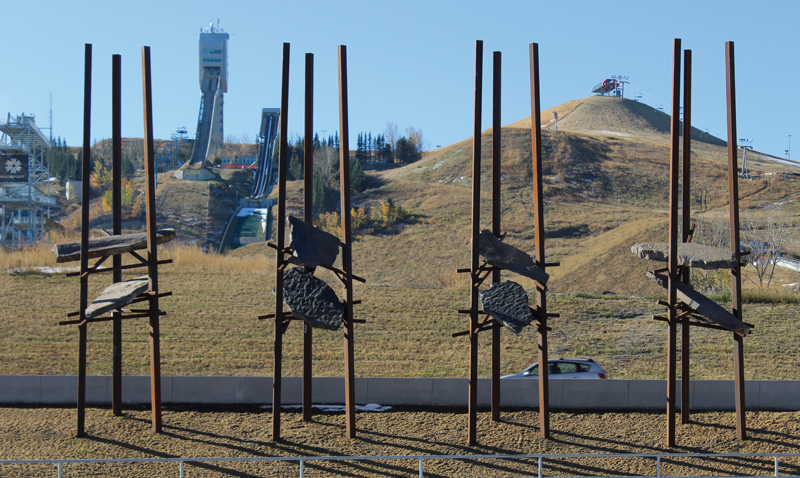
|
Triassic Towers (Bowfort Towers), City of Calgary, Alberta
On the Trans-Canada Highway, the sculpture serves as an entry marker to the City of Calgary. It is located at the base of Olympic Park.
The artwork celebrates of the geological history of the region, as part of the Earth’s ancient and contemporary environment, which affects us all. The stone is elevated, ‘floating’, to signify its importance. The Rundle stone becomes an icon for the environment.
This sculpture is inspired by unique ‘specimen stones’ obtained from the personal collection of Louis and Brenda Kamenka, geologist, and owners of the Kamenka Quarry near Canmore. Over many years, Louis carefully placed aside special stones he which he had discovered within the family quarry, established 65 years ago. This indigenous stone is a very hard, durable and enduring sedimentary quartz sandstone-siltstone.
The Rundle stone slabs hold a richness of the regional history of the earth. Its surfaces of fossilized water ripples and fossils of ancient creatures, was formed in an ocean that existed locally about 225 million years ago, during the Triassic Period.
Rundle Rock is rare. Found only in Alberta, and nowhere else in North America. From a geological viewpoint, it holds within each bedding plane the tremendous story of survival which took place on our planet during a period of mass extinction. The individual layers of stone record this history and the events that took place on a prehistoric ocean floor. Water ripple marks and fossil traces are common, including imprints of life species which flourished then, such as Ammonites, Brachiopods, Clams and Fishes.
The towers are situated within the previous Glacial Lake Calgary, from the Pleistocene Epoch ice age. The fact that 100,000 years ago these towers would be standing under water, adds poignancy to the water ripples and creatures of the Rundle stone.
Each tower has symmetrically triangulated poles placed a 15 degree angle, giving a sense of rotation. The upper parts of the towers are open, embracing and invoking the sky. The stones are placed in the center area elevated in a manner whereby the slabs interact with each other. The bases of the towers are rooted into the Earth. The towers become sentinels, with their unique stone and symbolism.
The tower material, corten steel, with an iron oxide patina, is in harmony with the Rundle stone which has visible iron oxide content. Iron as the most abundant element on Earth, constitutes 35% of the mass of the Earth. This is a sculpture of realism. The sculpture is not to be considered abstract as it carries only actual stone from 225 million years ago, asserting evidence of their history.
The artwork gives viewers a focal image towards Calgary’s environmental history, by using the actual stones which tell wonderful very ancient stories.
Consulting with leaders from the First Nations community, we were advised that the number ‘four’ holds great symbolic importance. Therefore, these four towers respectfully align with the proper numerical symbolism.
The sculpture was wholly constructed in Calgary. The quality craftsmanship of the steel towers and installation is by Metal-Fab Industries, in Calgary. Their expert rigging allowed me to, visually, fine-tune the stones to interact and speak to each other. The quality stonework is by Amico Stone Supply, of Calgary. I also thank Brenda and Louis Kamenka of Kamenka Quarry, and all the local professional advisors who were a part of this project.
In harmony, the earthworks element of the public artwork under construction, designed by artist Patricia Leighton with landscape architect Taewook Cha of Supermass Studio, will be located on the north side of the highway. The undulating landscape will bear the markings of glacial flow fusing the past and present, echoing the spirit of place and energy of the land.
Del Geist, 2018  
|